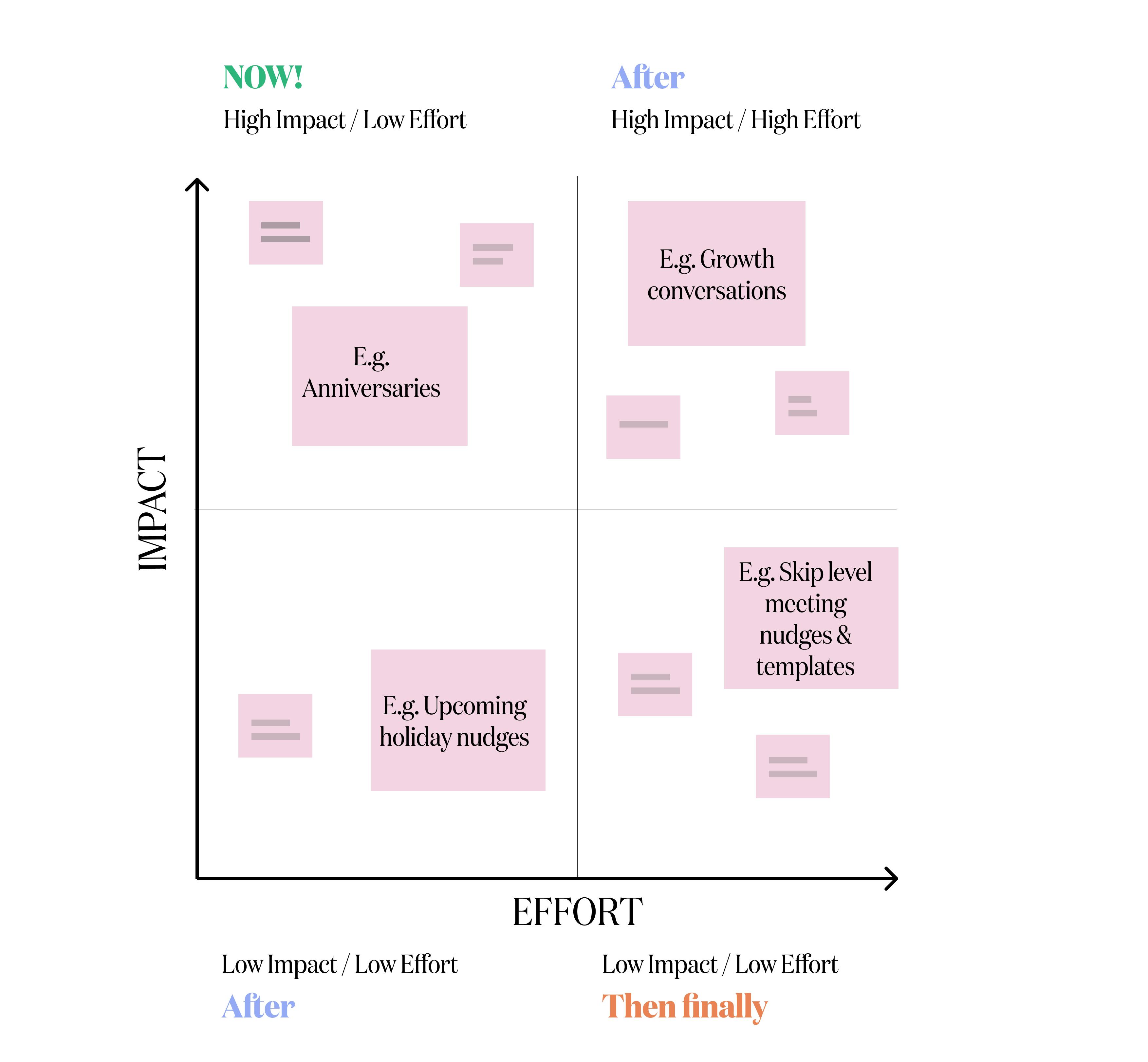
Prioritizing moments that matter on your Employee Journey Map
Explore frameworks that can help you prioritize moments across your Employee Journey Map

Written by
Alexis (Lexi) Croswell,
When getting started building your first Employee Journey Map, in addition to finding the right tool to build it, you’ll need to decide where to start.
Should you start with employee onboarding since it’s important to make a good first impression? Or should you begin with supporting new managers because their impact affects many employees?
At the end of the day, what’s important is that you do start somewhere. You could pick a point on the employee journey that affects the most people and start there. It can be that simple.
However, there are many other factors to consider, if you want to. In this article, we’ll explore different frameworks for prioritizing the most impactful moments that matter on your Employee Journey Map. The goal is to help you make the biggest positive improvement to your employee experience in the shortest amount of time.
What are moments that matter?
Moments that matter are the touchpoints people encounter during their journey that have an outsized impact on the employee’s experience.
You can think about moments that matter across three dimensions: how they’ll impact the employee, their manager, and the employer. There are often specific desired behaviors and outcomes for each group in a moment that matters.
These moments are often times of transition (e.g. becoming a manager) or an event that someone may be experiencing for the first time (e.g. parental leave). For these reasons, these moments require you to provide people with more support.
Prioritizing moments on your Employee Journey Map
“People remember the beginning, the peak, and the end. If you don't know where to start, I would say make the first day a great experience and make the exit also a good one, because this helps people remember you,” says Felicitas Schweiker, VP of People & Culture at parcelLab who uses an Employee Journey Map with her team.
Remy Bleijendaal, Chief People Officer at data.ai, adds that it can be helpful to look at what’s most broken across your employee journey. “When I started at data.ia, we measured the whole experience and it was clear that we had a challenge in recruitment. We were taking too long to close roles, so that’s where we focused,” he explains.
You should review whatever internal data you have, like employee engagement surveys, headcount projections, turnover rates, etc. to help you select what will be most impactful based on where there are challenges.
There are some moments that are table stakes, says Remy. “You need a good baseline to start with,” he says. These moments need to be delivered otherwise your employees cannot grow. We’ve outlined a few moments we see as a good baseline below, and our reasons why.
Onboarding
- All employees experience onboarding so it impacts the most people
- First impressions matter: “Employees who had effective onboarding feel up to 18x more commitment to their workplace,” according to BambooHR onboarding stats.
Life events
- Birthdays, work anniversaries, and parental leave are three key life events to cover.
- Milestones like anniversaries and birthdays are epiphany moments - natural occasions for reflection and often catalysts for life changes.
- Work anniversaries are a time when job-hunting activity tends to increase by as much as 9% (HBR research)
Becoming a manager
- New managers need additional support and training to do their best work.
- Managers impact others at your organization. At least 75% of voluntary turnover can be influenced by managers.
Career development
- While new hires and managers often get support, the ongoing development of your entire workforce is essential.
- Deloitte finds that companies with a strong learning culture are 92% more likely to develop novel products and processes, 52% more productive, 56% more likely to be the first to market with their products and services, and 17% more profitable than their peers.
Factor in your organization’s individual context
The frameworks we’ve outlined above are a good place to start for most organizations. This is because they typically happen within most organizations. New hires join, individual contributors are promoted to managers, work anniversaries occur.
That said, it’s important to factor in your organization’s individual context. If you’re not planning to hire many people, then don’t start with onboarding. If you are planning to bring employees back to the office, then start with a return to office plan and communications.
Considering your organization’s individual context is also an important input into overall HR strategy planning. For example, when deciding where to focus on your Employee Journey Map, you may want to get the input of your CEO and other department leaders. You could ask questions like:
- What are the company's top priorities right now?
- If you had 2 top priorities for the People function in the next 6 months, what would they be?
- Where is the People function adding the most value to the business (and where is it adding the least)?
- What do you think is the strongest asset of our culture (and where do we fall down)?
A group prioritization exercise
After you have listed your Moments that Matter, it’s time to prioritize your team work for the months, or year, ahead.
You may use one of several tools for your Journey Mapping. We recommend our new Employee Journey Designer (it's free).
Joris Luijke, Pyn's CEO and Cofounder shares fun and impactful way to plan your work. "Use an Effort/Impact Matrix to assess which of the Moments to upgrade first. Assign a Low/High score related to both Impact and Effort for each Moment then add them to the matrix pictured below."
Moments that are both “High Impact” and “Low Effort” may well be your low hanging fruits that you want to tackle this quarter!



